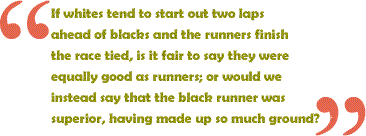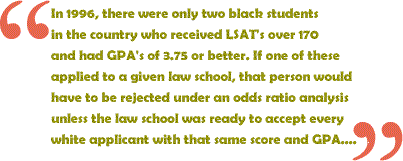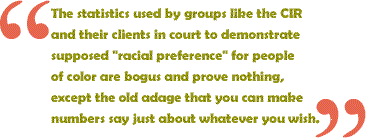This
article was originally published December 5 as a Znet Commentary,
by subscription at www.zmag.org
So
the Supreme Court has announced it will hear the long-simmering
affirmative action case from the University of Michigan law school,
in which white plaintiffs sued, claiming to have been denied admission
even though they had grades and test scores that were comparable
to those of students of color who were admitted.

The
case in question - which the Circuit Court decided in favor of the
law school and their affirmative action program - will now fall
into the lap of a high court that has been increasingly hostile
to such policies and tends to consider race-conscious affirmative
action efforts little more than illegitimate "racial preferences."
But
in truth, the plaintiff's claims of reverse discrimination (pieced
together by the right-wing Center for Individual Rights) are so
flimsy they would be almost laughable were they not so dangerous.
Understanding how the right manipulates data to make their case
is important for those who hope to stanch the movement to roll back
key civil rights gains. Indeed, the data is not only flawed but
also dangerous, for its acceptance as legitimate social science
- as will be seen below - could set a precedent for essentially
blocking the admission of blacks, Latinos and American Indians to
selective schools of higher education.
By
utilizing questionable statistical techniques, the plaintiffs claim
that black, Latino and American Indian applicants to the U of M
law school received preference over whites because they were often
accepted with GPA's and LSAT scores that for whites were met with
rejection.
According
to the plaintiffs, the odds of one of these "underrepresented
minority" students (URM's) being admitted were often hundreds
of times better than the odds of a white applicant with similar
scores and grades. Although the plaintiffs have never presented
evidence that the URM's admitted were unqualified - indeed they
conceded that all had been fully qualified - they insist that when
URM's and whites had equal qualifications, minority students were
more likely to be accepted, thereby indicating preference.
To
make their case at trial, the plaintiff's attorneys presented grid
displays that broke down those who applied and were admitted to
the law school by "qualification cells," separating students
into groups by GPA and LSAT (i.e., 3.5-3.75 GPA and 156-158 on the
LSAT, on a 120-180 scale).
Within
each cell, statistician Kinley Larntz calculated the odds of admission
for each student, concluding that URM's in many cells had greater
chances of admission than whites with the same grades and test scores.
He then calculated the odds ratios for each cell, so that if URM's
in a cell had a 50% chance of admission and whites had a 25% chance,
the odds ratio would be 2:1. The larger the odds ratio, the greater
the degree of presumed preference.
But
such an analysis is flawed. First, the data used to calculate admissions
odds ratios was limited. Whenever URM's and whites in a given cell
were treated the same - either all accepted or all rejected - Larntz
simply threw out their data and refused to consider it.
In
other words, by only examining cells where there was a differential
outcome, Larntz automatically inflated the size of that difference.
Overall, 40% of minority students who applied to the law school
were in cells that exhibited no racial differences in admission
odds ratios, meaning that claims of massive preference for URM's
depend on ignoring 40% of all applicants of color to the law school.
Secondly,
differential odds ratios for white and minority acceptance could
just as easily result from a system involving zero preference for
URM's, as from a system with large preference, largely due to the
small sample sizes of applicants of color.
 For
example, in 1996, among the most qualified applicants (students
with a 3.75 GPA or better and a f170 or higher on the LSAT), only
one black with these numbers applied to the U of M. This applicant
was accepted. 151 whites applied with these numbers and 143 were
accepted. While most everyone at this level was admitted, since
there was only one black who applied and got in, the "odds
ratio" in favor of blacks at that level appears infinite -
a guarantee for blacks and a less than certain probability for whites.
But surely one cannot infer from one accepted black out of one black
applicant at that level that there is some pattern of preference
operating.
For
example, in 1996, among the most qualified applicants (students
with a 3.75 GPA or better and a f170 or higher on the LSAT), only
one black with these numbers applied to the U of M. This applicant
was accepted. 151 whites applied with these numbers and 143 were
accepted. While most everyone at this level was admitted, since
there was only one black who applied and got in, the "odds
ratio" in favor of blacks at that level appears infinite -
a guarantee for blacks and a less than certain probability for whites.
But surely one cannot infer from one accepted black out of one black
applicant at that level that there is some pattern of preference
operating.
As
proof that one could produce odds ratios favoring blacks even in
the absence of racial preference for any individual URM, consider
the implications of a study by the Mellon Foundation and the Urban
Institute, which found that blacks tend to have faced greater educational
obstacles than whites with comparable scores on standardized tests.
When compared to whites with scores comparable to their own, blacks
in a particular range are far more likely to have come from low-income
families and families with less educational background.
These
black students are also more likely to have attended resource-poor
inner city schools where course offerings are more limited than
in the mostly suburban schools attended by whites. Thus, black students
can be said to have overcome more and even be more "qualified"
than whites who score in the same range or even a bit higher on
standardized tests.
As
such, it becomes easy to see how differential admissions odds ratios
could obtain even without "racial preferences." Simply
put, if whites tend to be better off and face fewer obstacles to
their educational success than blacks, and if blacks tend to be
worse off and face more obstacles, then any black applicant to a
college, law school or graduate school will likely have a greater
claim for their merit at a given test score level than a white who
scored the same.
To
visualize the point, imagine a four-leg relay race. If whites tend
to start out two laps ahead of blacks and the runners finish the
race tied, is it fair to say they were equally good as runners;
or would we instead say that the black runner was superior, having
made up so much ground?
Since
even the plaintiffs have agreed there is nothing wrong with considering
the obstacles faced by applicants, including the effects of racism,
it is quite possible that admissions officers could look at applicant
files, see whites and blacks with comparable scores, and then on
an individual basis make the determination that the black applicants
were more qualified, having overcome obstacles faced by far fewer
whites. But if individual analyses were completed with such a result,
they would produce the same odds ratios as discovered by Larntz.
In other words, differential odds ratios themselves prove nothing.
Indeed,
the implications of accepting differential odds ratios as evidence
of "reverse discrimination" are chilling, and would require
the rejection of almost all applicants of color  to
selective schools, simply because there are so few URM applicants.
to
selective schools, simply because there are so few URM applicants.
For
example, imagine an applicant pool at a hypothetical school where
there is only one URM applicant for each "qualification cell,"
perhaps because the school is in a very white location and doesn't
typically attract minority applicants. Under an odds ratio analysis
that assumed URM's couldn't have more favorable odds of admission
without this proving reverse discrimination, most URM's no matter
how competent would have to be rejected simply because to accept
one-out-of-one would represent "infinite odds" and require
the acceptance of every white in the same cell, merely to keep the
odds ratios the same.
So
although we could expect the whites and students of color at the
lowest level of scores to all be rejected and those at the top to
all be accepted, in the middle such a situation would create chaos.
If one black student applied with scores and grades that were good
but not a sure thing for admission, and 200 whites applied with
those same numbers, the school would have to accept every white
in that cell if they accepted the one black, or else face a lawsuit
for reverse discrimination on the basis of an unacceptably pro-black
admissions odds ratio.
Beyond
mere hypotheticals, there is real evidence of how reliance on odds
ratios would work in practice. In 1996, there were only two black
students in the country who received LSAT's over 170 and had GPA's
of 3.75 or better. If one of these applied to a given law school,
that person would have to be rejected under an odds ratio analysis
unless the law school was ready to accept every white applicant
with that same score and GPA, irrespective of other aspects of their
application file.
Now
imagine that the same year, 100 whites with those numbers applied
to the same school, and 80 of them were admitted, or 90, or 95;
and imagine that both of the blacks with those grades and scores
applied. Since admitting both of the blacks would yield odds ratios
unacceptably in favor of blacks, the school would have to reject
one of the clearly qualified blacks with those numbers (thereby
producing a large odds ratio in favor of whites) just to avoid being
sued for reverse discrimination!
Even
the strongest evidence of URM racial preference at U of M indicates
the problem with utilizing odds ratio analyses. Larntz notes, for
example, that among applicants in 1999 with a 3.5-3.7 GPA and LSAT's
of 156-158, six of seven URM's were admitted, while only one of
seventy-three whites at that level were accepted. This yields an
odds ratio of 432:1 in favor of URM's at that level: a seemingly
huge racial preference. But there are two problems.
First,
with only seven black, Latino or Indian applicants to the U of M
School of Law in that particular "qualification cell,"
it is entirely possible that the admissions officers who decided
to accept six of those seven merely examined the files and found
that those six had overcome extraordinary obstacles (including racism
and perhaps economic hardship), unlike the white applicants. Thus,
the ratio itself, absent other evidence about the particular decision-making
of admissions officers, cannot prove a preference for URM's, as
the pool is simply too small.
Secondly,
to balance the odds ratios for this cell would have been impossible.
If seven of eighty applicants with that combination of test scores
and grades was worthy of acceptance--essentially what the University
said that year--this yields an acceptance  probability
at that level of 8.75%. Applying that probability to each group
yields six whites out of 73 who should be accepted and 0.6 URM's
out of seven who should be. In other words, because of the small
pool of URM's in that group, it wouldn't be possible to admit even
one, let alone one black, one Latino and one American Indian, without
giving a much higher probability of admission to URM's as a group.
probability
at that level of 8.75%. Applying that probability to each group
yields six whites out of 73 who should be accepted and 0.6 URM's
out of seven who should be. In other words, because of the small
pool of URM's in that group, it wouldn't be possible to admit even
one, let alone one black, one Latino and one American Indian, without
giving a much higher probability of admission to URM's as a group.
But
for the sake of argument, let's say the school rounded up the six-tenths
of a person to one full person and admitted one URM with these numbers.
Thus, instead of 6 URM's and 1 white admitted (the actual numbers
for 1999), we would get the opposite: 6 whites and 1 URM. The problem
is, even with that "correction," the probability of acceptance
for URM's would be 14.3%, while for whites it would be 8.2%, meaning
there would still be an unacceptable odds ratio favoring people
of color simply as a function of sample size. So even under a "race-blind"
process that sought to avoid different probabilities for different
groups, it would be impossible to eliminate favorable odds ratios
for people of color, without basically rejecting the vast majority
of URM applicants outright.
The
fact is, the current attack on affirmative action is based on a
lie; the lie of reverse discrimination. The statistics used by groups
like the CIR and their clients in court to demonstrate supposed
"racial preference" for people of color are bogus and
prove nothing, except the old adage that you can make numbers say
just about whatever you wish. It is incumbent upon those of us who
support affirmative action to confront these lies and flawed data
head-first; to demonstrate conclusively on which side of the bread
one continues to find the butter in this society (hint: it ain't
the rye side), and to show beyond any doubt that the right-wing
crusade against racial equity is supported by smoke and mirrors,
not hard facts.
The
facts are plain. There is no racial preference for minority students
at the University of Michigan Law School. In 1997, for example (one
of the years covered by the lawsuit), 34% of black applicants were
admitted to the Law School while 39% of white applicants were admitted.
More recently, in 2000, 36% of black applicants were admitted, while
41% of white applicants were. If that's reverse discrimination,
I'm having a hard time making out the victims.
Tim
Wise is an antiracist writer, lecturer and activist. He can be reached
at (and footnotes can be obtained from), [email protected]


